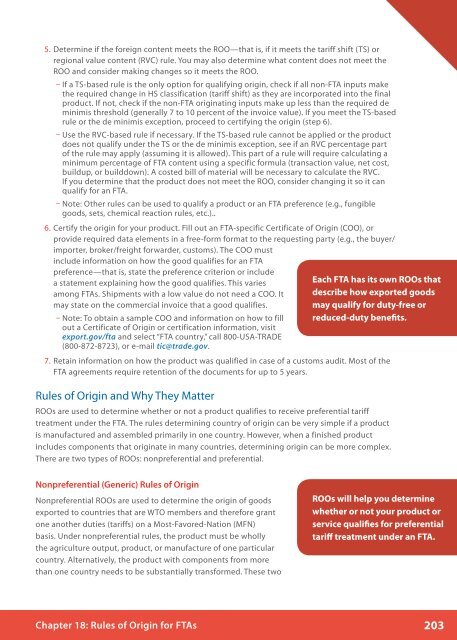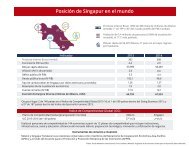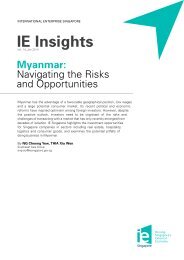basic-guide-to-exporting_Latest_eg_main_086196
basic-guide-to-exporting_Latest_eg_main_086196
basic-guide-to-exporting_Latest_eg_main_086196
You also want an ePaper? Increase the reach of your titles
YUMPU automatically turns print PDFs into web optimized ePapers that Google loves.
5. Determine if the foreign content meets the ROO—that is, if it meets the tariff shift (TS) orr<strong>eg</strong>ional value content (RVC) rule. You may also determine what content does not meet theROO and consider making changes so it meets the ROO.ŦŦIf a TS-based rule is the only option for qualifying origin, check if all non-FTA inputs makethe required change in HS classification (tariff shift) as they are incorporated in<strong>to</strong> the finalproduct. If not, check if the non-FTA originating inputs make up less than the required deminimis threshold (generally 7 <strong>to</strong> 10 percent of the invoice value). If you meet the TS-basedrule or the de minimis exception, proceed <strong>to</strong> certifying the origin (step 6).ŦŦUse the RVC-based rule if necessary. If the TS-based rule cannot be applied or the productdoes not qualify under the TS or the de minimis exception, see if an RVC percentage par<strong>to</strong>f the rule may apply (assuming it is allowed). This part of a rule will require calculating aminimum percentage of FTA content using a specific formula (transaction value, net cost,buildup, or builddown). A costed bill of material will be necessary <strong>to</strong> calculate the RVC.If you determine that the product does not meet the ROO, consider changing it so it canqualify for an FTA.ŦŦNote: Other rules can be used <strong>to</strong> qualify a product or an FTA preference (e.g., fungibl<strong>eg</strong>oods, sets, chemical reaction rules, etc.)..6. Certify the origin for your product. Fill out an FTA-specific Certificate of Origin (COO), orprovide required data elements in a free-form format <strong>to</strong> the requesting party (e.g., the buyer/importer, broker/freight forwarder, cus<strong>to</strong>ms). The COO mustinclude information on how the good qualifies for an FTApreference—that is, state the preference criterion or includea statement explaining how the good qualifies. This variesamong FTAs. Shipments with a low value do not need a COO. Itmay state on the commercial invoice that a good qualifies.ŦŦNote: To obtain a sample COO and information on how <strong>to</strong> fillout a Certificate of Origin or certification information, visitexport.gov/fta and select “FTA country,” call 800-USA-TRADE(800-872-8723), or e-mail tic@trade.gov.7. Retain information on how the product was qualified in case of a cus<strong>to</strong>ms audit. Most of theFTA agreements require retention of the documents for up <strong>to</strong> 5 years.Rules of Origin and Why They MatterEach FTA has its own ROOs thatdescribe how exported goodsmay qualify for duty-free orreduced-duty benefits.ROOs are used <strong>to</strong> determine whether or not a product qualifies <strong>to</strong> receive preferential tarifftreatment under the FTA. The rules determining country of origin can be very simple if a productis manufactured and assembled primarily in one country. However, when a finished productincludes components that originate in many countries, determining origin can be more complex.There are two types of ROOs: nonpreferential and preferential.Nonpreferential (Generic) Rules of OriginNonpreferential ROOs are used <strong>to</strong> determine the origin of goodsexported <strong>to</strong> countries that are WTO members and therefore gran<strong>to</strong>ne another duties (tariffs) on a Most-Favored-Nation (MFN)basis. Under nonpreferential rules, the product must be whollythe agriculture output, product, or manufacture of one particularcountry. Alternatively, the product with components from morethan one country needs <strong>to</strong> be substantially transformed. These twoROOs will help you determinewhether or not your product orservice qualifies for preferentialtariff treatment under an FTA.Chapter 18: Rules of Origin for FTAs203





